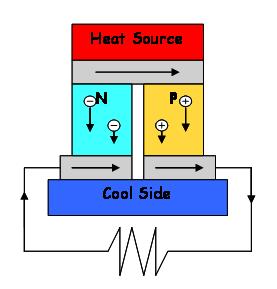The majority of the world’s power is generated by heat energy. Usually, the heat energy is used to convert water into steam which then drives massive turbine power generators to produce the electricity we use in our homes. However, this process is quite inefficient – around 60-70% of the energy is lost during the conversion process. Thermoelectric power generation offers a way to reduce this inefficiency. Thermoelectric devices utilize the Seebeck effect: when a conducting material is placed in a temperature gradient a potential difference is setup along the gradient. The sign of the gradient is related to the type of carrier, electrons (negative) or holes (positive). Thus using these two types of materials in parallel creates an electric pump that converts heat energy directly to electricity with an efficiency of around 10% (see the figure below for a schematic of a thermoelectric power generator). Hence any industrial or even commercial or domestic process that produces waste could be use this technology to ‘recoup’ the lost energy.
 However, so far the technology has only found niche markets, for example, in the transportation sector several automotive companies use thermogenerators to convert the waste heat from internal combustion engines into electricity to recharge on-board car batteries. Full realization of its potential has been hampered by a lack of suitable materials. The most efficient and reliable material is currently bismuth telluride, a material discovered in the sixties! There is now a global research effort to search for new thermoelectric materials, the prize of which could be a multi-million pound industry to supply world markets with thermogenerator devices.
However, so far the technology has only found niche markets, for example, in the transportation sector several automotive companies use thermogenerators to convert the waste heat from internal combustion engines into electricity to recharge on-board car batteries. Full realization of its potential has been hampered by a lack of suitable materials. The most efficient and reliable material is currently bismuth telluride, a material discovered in the sixties! There is now a global research effort to search for new thermoelectric materials, the prize of which could be a multi-million pound industry to supply world markets with thermogenerator devices.1. Computer simulation of thermoelectric materials. The Seebeck effect is governed by the electronic band structure of the material and this band structure can be calculated using sophisticated computer techniques. Edinburgh is home to both the UK’s most powerful supercomputer, the Cray XT and the group of Prof. Graeme Ackland, a UK leader in band structure calculation. We run projects to both model existing thermoelectric materials and develop algorithms to predict new materials.
2. The material synthesis team is lead by Dr. Robin Perry with Prof. Andrew Huxley. The group specialises in synthesis of novel materials and works closely with the solid state chemistry group of Prof. Attfield. Not only do we run projects on conventional binary thermoelectrics, but we also are interested in transition metal oxide, lanthanide and actinide containing materials.
3. Measurement of thermoelectric materials. We have facilities in Edinburgh to study all aspects of the thermoelectric properties of materials. This includes X-ray and electron microprobe analysis suites for metallurgical analysis and a Quantum Design Physical Property Measurement System for measuring the transport properties of materials between 400K and 2K. This system is run by Dr. Konstantin Kaminev from the Engineering department. We also are developing new measurement techniques for studying thermal properties under pressure with a project lead by Dr. Anna Kusmartseva (Chemistry).
Click in the following hyperlinks to be redirected to Solar Power or Nuclear Energy.
Diagram: from Wikipedia